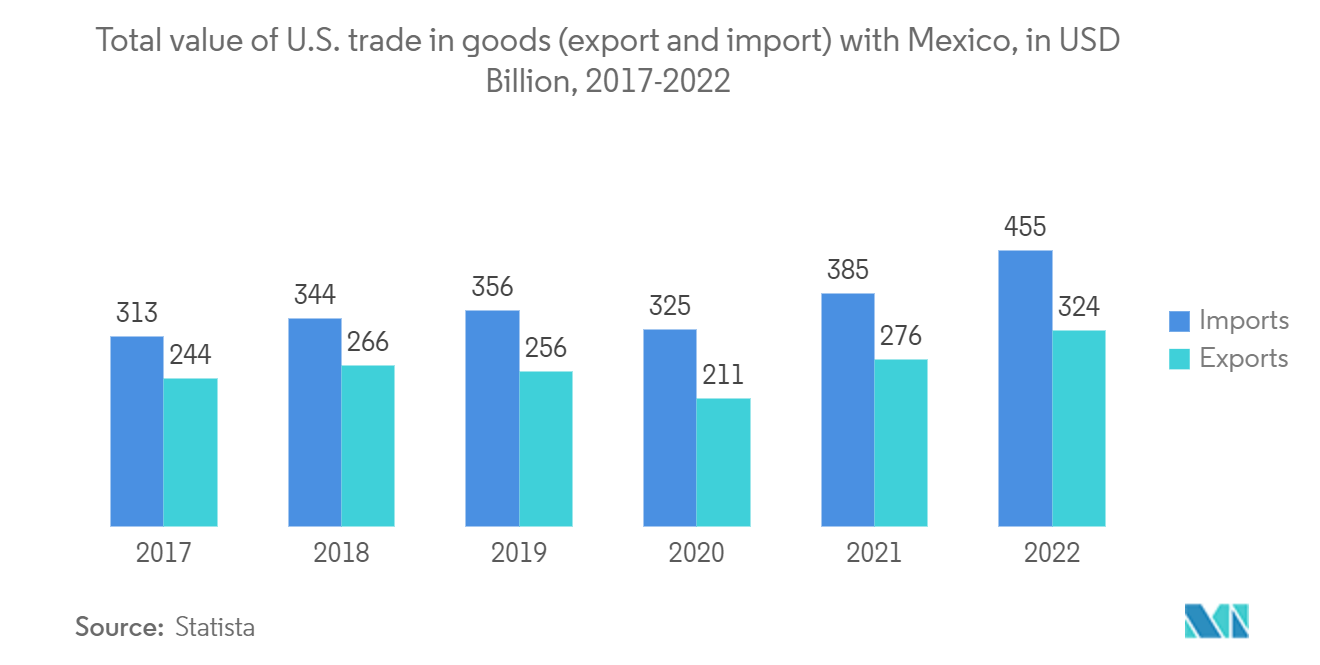Market Trends of Mexico Freight Forwarding Industry
Increase in sea freight driving the market
- The most evident and noticeable trend that has gained traction since the third quarter of 2022 has been the decrease in ocean freight rates. After steadily rising – to record levels – since the second half of 2020, freight rates came under pressure following the Russia-Ukraine war, when concerns about the economic consequences began to dampen consumer morale and put a shadow on international trade and freight transit. Rates stayed at record levels in Q2 2022 but started to drop steadily in Q3 2022 before undergoing a steep decline towards the end of 2023. Ocean shipping rates had lost all the gains earned in the previous two years (except for trans-Atlantic traffic) as of the beginning of 2023 and were nearly flat by then.
- According to Mexico's Ministry of the Navy (Semar), a total of 13,929 vessels arrived in commercial ports in the first eight months of 2022, representing a 1.6% increase over the same time in 2021. Another industry that experienced a notable resurgence was motor vehicles, which increased by 11.2%, or 1.19 million units, compared to 1.07 million units at the same time in 2021. Oil and petroleum products climbed by 2.1% year on year to 71.8 million tonnes in January-August, compared to 70.3 million tonnes in 2021. Agricultural bulk increased by 2.4% from January to August 2022, reaching 11.5 million tonnes, up from 11.2 million tonnes in the same period in 2021. Meanwhile, bulk ore experienced a 0.3% annual rate increase to 43.9m tonnes.

Increase in foreign trade driving the market
- Mexico's business relations with its biggest trading partner, the United States, account for more than three-quarters of the country's exports. Mexico's other export destinations are Canada, China, Germany, and Japan. Imports are primarily from the United States, China, South Korea, Germany, and Japan. Mexico has inked a dozen free-trade agreements with over forty countries throughout the world. Mexico's other commercial advantages include the United States-Mexico-Canada deal (which will replace NAFTA in 2020), its free-trade deal with the European Union since 2000, a trade pact with Japan since 2005, and the establishment of the Pacific Alliance in 2012 with Colombia, Chile, and Peru.
- Mexico is heavily reliant on foreign commerce, which accounts for 83.6% of its GDP in 2021 (World Bank, most recent available statistics). Cars (14.3%), automatic data processing devices (6.7%), vehicle parts (6.2%), petroleum products (4.8%), and monitors and projectors (3.2%) are the primary exports of the country. Mexico's largest imports include automobile parts and accessories (5.1%), petroleum oils (4.9%), electronic integrated circuits (4.3%), petroleum gas (3.1%), and telephone sets (2.7%). According to IMF Foreign Trade Forecasts, the volume of goods and services exported climbed by 6.9% in 2022 and is forecast to fall by 0.5% in 2023, while imports increased by 5.4% in 2022 and are expected to increase by 0.5% in 2023.
- Mexico belongs to the World Trade Organisation (WTO), the Asia-Pacific Economic Cooperation (APEC), the Group of 20 (G-20), and the Organisation for Economic Cooperation and Development (OECD). Mexico has 13 free trade agreements (FTAs) encompassing 50 countries, including the Comprehensive and Progressive Agreement for Trans-Pacific Partnership (CPTPP, formerly known as the Trans-Pacific Partnership), which covers 11 nations. For American exporters, Mexico's involvement in these international agreements implies that the Mexican market is generally open and competitive.


